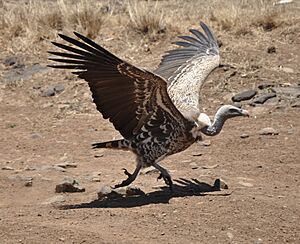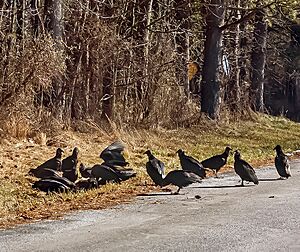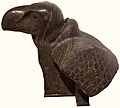Vulture facts for kids
A vulture is a type of bird of prey that eats dead animals, also known as scavenging on carrion. There are 23 different kinds of vultures alive today, including large birds called condors.
There are two main groups of vultures:
- Old World vultures: These 16 species live in Europe, Africa, and Asia.
- New World vultures: These 7 species live only in North and South America. They all belong to the Cathartidae family.
Many vultures have a special feature: a bald, unfeathered head. This bare skin helps keep their heads clean when they are eating. It also helps them control their body temperature. Vultures might hunch their bodies and tuck in their heads when it's cold. When it's hot, they spread their wings and stretch their necks to cool down.
When vultures fly together, they are called a "kettle." A group of vultures resting on the ground or in trees is called a "committee." If a group of vultures is eating, it's called a "wake."
Contents
Vulture Families
Even though New World vultures and Old World vultures look very similar, they are not closely related. They look alike because of something called convergent evolution. This means they developed similar features because they live in similar ways, not because they share a recent ancestor.
Early scientists thought all vultures were part of the same group. But soon, they realized that Old World and New World vultures were different. New World vultures were placed in their own family, called Cathartidae. This name comes from a Greek word meaning "purifier," because they help clean up the environment.
Old World Vultures

Old World vultures live in Africa, Asia, and Europe. They are part of the Accipitridae family, which also includes other birds like eagles, kites, buzzards, and hawks. Old World vultures find dead animals mainly by seeing them from high up in the sky.
There are 16 species of Old World vultures, including:
- Cinereous vulture
- Griffon vulture
- White-rumped vulture
- Rüppell's vulture
- Indian vulture
- Slender-billed vulture
- Himalayan vulture
- White-backed vulture
- Cape vulture
- Hooded vulture
- Red-headed vulture
- Lappet-faced vulture
- White-headed vulture
- Bearded vulture (also called Lammergeier)
- Egyptian vulture
- Palm-nut vulture
New World Vultures
New World vultures and condors live in the warm and mild parts of the Americas. They belong to the Cathartidae family. Scientists now believe they are related to other birds of prey like hawks and eagles.
Some New World vultures have a very good sense of smell. This is unusual for raptors. They can smell dead animals from far away, even up to a mile!
There are seven species of New World vultures:
- Black vulture (found in South America and up to the US)
- Turkey vulture (found across the Americas, up to southern Canada)
- Lesser yellow-headed vulture (found in South America and up to Mexico)
- Greater yellow-headed vulture (found in the Amazon Basin of South America)
- California condor (found in California, used to live across western North America)
- Andean condor (found in the Andes mountains)
- King vulture (found from southern Mexico to northern Argentina)
What Vultures Eat
Vultures are scavengers, which means they eat dead animals. They are the only animals on land that mostly eat only dead things. Vultures rarely attack healthy animals. However, they might kill animals that are already hurt or sick.
If a dead animal's skin is too tough for a vulture's beak to open, the vulture will wait for a bigger animal to eat first. Vultures eat a lot when there's plenty of food. They fill their crops (a pouch in their throat) until it bulges. Then they rest to digest their meal.
Vultures do not carry food to their young with their feet. Instead, they bring food back in their crops and then spit it out for their babies. The bearded vulture, which lives in mountains, is special because it mostly eats bones! It carries bones to its nest for its young. It also hunts some live prey.
Vultures are very important because they help clean up the environment, especially in hot places. Their stomach acid is extremely strong (very low pH). This allows them to safely digest rotten animals that might have dangerous bacteria, like those causing anthrax. By eating these carcasses, vultures help remove harmful bacteria from the environment.
New World vultures sometimes vomit when they feel threatened. They don't aim their vomit at attackers to defend themselves. Instead, they vomit to make themselves lighter so they can fly away more easily. The vomited food might also distract a predator, giving the vulture a chance to escape.
In Africa, vultures often compete with predators like lions, cheetahs, and hyenas for food. Vultures watch these predators closely to find out where they are hunting. Vultures usually wait patiently until the predators have finished eating and left the dead animal. Then, the vultures swoop in to eat the leftovers.
New studies show that vultures can also hear sounds that tell them where food might be. Sometimes, if there are not many predators around or if the predators are busy, vultures might try to get food earlier. This is a risky move, but it shows how much they want to find food in the wild.
New World vultures also pee down their legs. The acid in their pee kills bacteria that they pick up from walking on dead animals. It also helps them cool down.
Vulture Protection
Vulture numbers in South Asia, especially in India and Nepal, have dropped a lot since the early 1990s. It might take many years for their populations to recover. Nepal's government has started taking steps to protect the vultures that are left.
Vultures across Africa and Asia are in danger. Many human activities threaten them, such as poisoning and hitting wind turbines. In central Africa, people are working to protect the remaining vultures and help their numbers grow. A big reason for the decline is the trade in vulture meat. Also, many vultures die from poisoning, both on purpose and by accident. One study found that poisoning caused 61% of vulture deaths.
A study in 2016 found that out of 22 vulture species:
- Nine are critically endangered (meaning they are very close to disappearing).
- Three are endangered.
- Four are near threatened.
- Six are of least concern (meaning they are not currently in danger).
Protecting vultures is important for humans too. If vulture numbers drop, there can be more diseases. This is because other animals that carry diseases, like rats or insects, might increase if vultures are not there to eat dead animals. Vultures help control these pests and disease carriers by competing with them for food.
Vultures in Stories and Art

In Ancient Egyptian art, the goddess Nekhbet was shown as a vulture. She was a protector of a city and of Upper Egypt. Many queens in ancient Egypt wore special vulture crowns, which symbolized protection from Nekhbet.
Ancient Egyptians believed that all vultures were female and were born from eggs without a male. Because of this, they connected vultures to purity and motherhood. They also linked them to the idea of death and rebirth. This was because vultures eat dead things and waste, turning "death" into life.
In ancient times in the Americas, vultures were seen as special creatures. They were very important in art and stories. They appear in many myths, legends, and fables from civilizations like the Maya and Aztecs. Sometimes they were shown in a negative way, and sometimes in a positive way.
Images for kids
-
African hooded vulture in Kruger National Park
-
Granite vulture from Temple of Taharqa, Sanam Abu Dom, Napatan Period, 25th Dynasty
See also
 In Spanish: Buitre para niños
In Spanish: Buitre para niños
- Jatayu
- Stele of the Vultures
- Vulture fund











